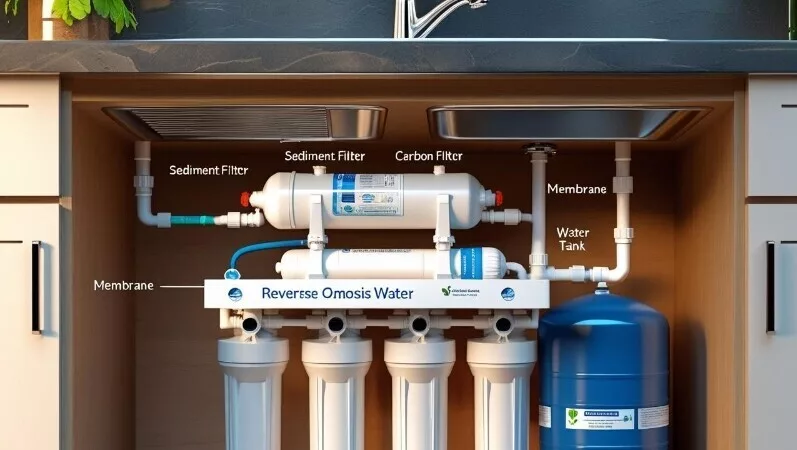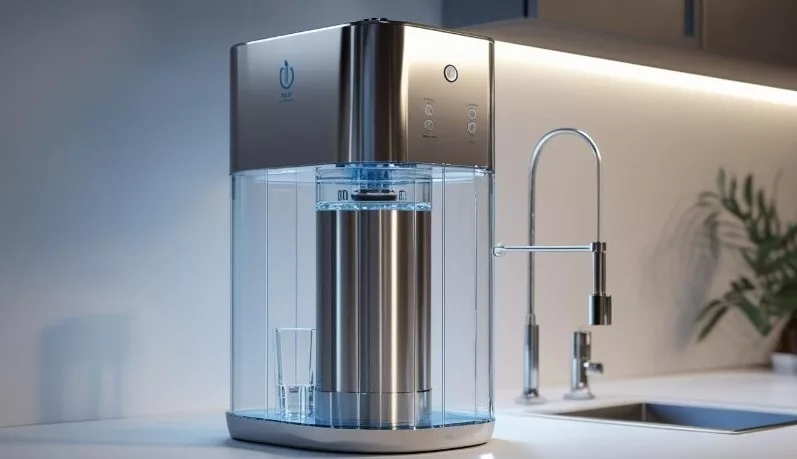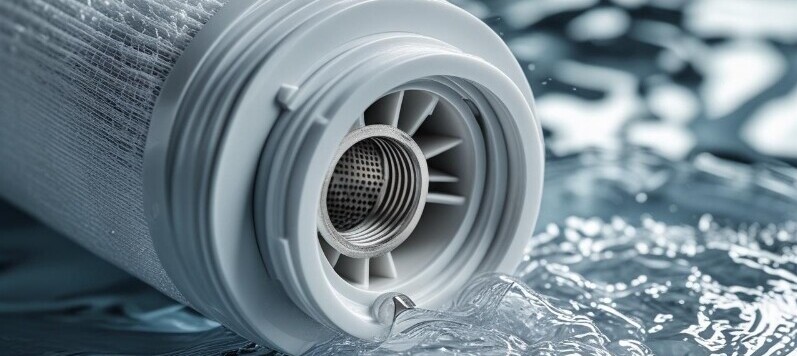Table of Contents
Sustainable water filtration is crucial these days as we face mounting environmental challenges and growing concerns about water quality. The impurities lurking in our water supply can range from organic contaminants and heavy metals to chlorine and microorganisms. Each of these poses distinct risks to our health and wellbeing.
Opting for eco-friendly water filtration systems helps mitigate these risks while also caring for our planet. These systems are built with sustainable materials and designed to minimize energy consumption and waste production. By choosing them, we make a positive impact on both our health and the environment.
Several key methods stand out when it comes to eco-friendly water filtration. From the use of natural materials like activated carbon and coconut shells to advanced technologies like reverse osmosis and UV purification, the options are plentiful and varied. Each method brings its own set of benefits and can be tailored to meet specific needs.
In this article, I’ll guide you through some of the most effective eco-friendly solutions available today. Whether you’re looking to improve the quality of your drinking water or reduce your environmental footprint, understanding these options will empower you to make informed decisions for a healthier future.
Activated Carbon and Coconut Shell Carbon Filters: Natural Purifying Power

Activated carbon filters are popular for their ability to improve the taste and odor of water, making it more pleasant to drink. They work by adsorbing impurities as water passes through, effectively capturing substances like chlorine, volatile organic compounds, and other contaminants.
Coconut shell carbon filters, on the other hand, are a unique twist on the traditional activated carbon method. Made from renewable coconut shells, these filters offer excellent adsorption properties. They’re great for reducing sediments and additional unwanted particles in your water supply.
In comparing these filters, both offer sustainable advantages due to their renewable materials. However, coconut shell carbon can often provide better adsorption due to its micro-pores, allowing it to capture smaller particles more effectively.
If you’re considering installing a filtration system, look at how these types of filters have transformed water quality in homes. Many users report significant improvements not only in taste and smell but also in overall water purity, contributing to better health outcomes.
Versatile Filtration: The Role of Reverse Osmosis and UV Purifiers

Reverse osmosis systems are recognized for their ability to remove a broad spectrum of contaminants. Though they do require energy to operate, modern advancements have made these systems far more efficient. Today’s models focus on reducing wastewater and energy consumption, making them a more sustainable choice than older versions.
Choosing between reverse osmosis and UV purification often depends on your specific water needs. Reverse osmosis covers a wide range of contaminants including heavy metals and nitrates, while UV is ideal for eliminating microorganisms without altering the taste of water.
UV purifiers take a distinct approach by using ultraviolet light to destroy harmful microorganisms in the water. They do not rely on chemicals, which means there’s no risk of chemical residues or by-products. UV systems are a great addition to households concerned about bacteria and viruses, offering a chemical-free solution.

These technologies have proven their value in various settings, from urban homes to remote areas, providing clean drinking water reliably. By selecting the right system for your needs, you contribute to a cleaner, healthier environment for yourself and potentially reduced reliance on single-use plastic water bottles.
Harnessing Nature: Rainwater Harvesting and Bio-Sand Filters

Rainwater harvesting systems offer an innovative way to capitalize on natural precipitation. By capturing rainwater, these systems reduce your dependency on traditional water supplies, which can cut down on water bills and environmental impact. With the right filtration, harvested rainwater is suitable for various uses, including drinking and irrigation.
Bio-sand filters, on the other hand, are an embodiment of simplicity and effectiveness. They utilize layers of sand and gravel to filter out contaminants, relying on natural biological processes to purify water. Their low-tech nature makes them accessible and affordable, perfect for areas where more complex systems are impractical.
The environmental benefits of using both rainwater harvesting and bio-sand filters are substantial. Reducing reliance on municipal water systems and leveraging the earth’s natural resources contribute to sustainable living practices.
For those looking to implement these systems, it’s crucial to consider the environmental conditions and specific water needs. However, embracing either—or both—of these methods can lead to significant long-term benefits, promoting a self-sufficient and eco-friendly lifestyle.
Extending Filtration Benefits: The Utility of Sediment Filters

Sediment filters are often the unsung heroes in the world of water filtration. They tackle the job of removing larger particles, such as dirt and sand, which can compromise the effectiveness of more refined filtration systems. By acting as a protective barrier, these filters prolong the lifespan of primary filtering systems like activated carbon or reverse osmosis units.
The importance of maintaining sediment filters cannot be overstressed. Regular cleaning or replacement ensures they function effectively, keeping larger particles from clogging subsequent filtration stages. This maintenance is a relatively straightforward process, but it plays a crucial role in sustaining the overall efficiency of your water filtration setup.
Incorporating sediment filters into your filtration system is a smart move for anyone aiming to maximize their system’s longevity and efficiency. For households relying on well water or those in areas prone to high mineral content, these filters offer a vital line of defense against premature wear and tear on more sensitive filtration mechanisms.
Understanding how sediment filters fit into your broader water filtration strategy can make a significant difference. Not only do they enhance the effectiveness of eco-friendly systems, but they also ensure you’re consistently receiving the cleanest water possible.

Thanks for sharing an informative post!
This article offers a clear and thorough look at eco-friendly water filtration options, balancing technical details with easy-to-understand explanations. It highlights the importance of sustainable methods like activated carbon, reverse osmosis, UV purification, rainwater harvesting, and bio-sand filters, showing how each contributes to cleaner water and a healthier planet. The inclusion of sediment filters as a key to system maintenance is a helpful practical tip. Overall, it encourages informed choices that protect both health and the environment while promoting long-term sustainability.
Looking forward to your future posts!
Keep up the good work!
I really enjoyed this article—it’s refreshing to see how eco‑friendly water filtration is gaining momentum. It’s especially inspiring how these methods tackle contamination, reduce plastic waste, and empower local communities. I’d love to learn more about the scalability of nanofiber systems versus traditional biosand filters. Great job highlighting diverse, sustainable approaches!
As someone who works in this type of role currently I absolutely loved this article it hits a timely and important note in such a practical way!
What stood out to me most is how it blends environmental responsibility with personal health. It’s easy to think of water filtration as just a way to get “cleaner” water, but this piece really connects the dots between what’s good for us and what’s good for the planet. That’s a refreshing angle pun fully intended!
The comparison between coconut shell carbon filters and traditional activated carbon was especially interesting. I had no idea coconut shells offered such strong filtration power due to their micro-pore structure. It’s a brilliant example of how something as simple and renewable as a coconut can play a key role in sustainability. That’s the kind of innovation I love hearing about clean tech that doesn’t feel overly complicated or inaccessible.
And the breakdown of reverse osmosis vs. UV purification? Super helpful. It’s great that both options cover different bases like heavy metals vs. microorganisms, so you can really tailor your choice to your needs instead of going with a one-size-fits-all solution. Plus, knowing that UV systems don’t leave chemical residues? That’s a big win.
The mention of bio-sand filters and rainwater harvesting really brings it home, especially for people in rural or off-grid locations. It’s encouraging to know that sustainable drainage solutions don’t always have to be high-tech they can be grounded, natural, and affordable too as many are here within the UK, especially those used by developers!.
All in all, this was a great reminder that sustainability isn’t just about huge lifestyle changes. Even something as everyday as how we filter our water can be part of the bigger picture. Thanks for breaking it down so clearly and practically, Shannon!
Kind regards,
Martin